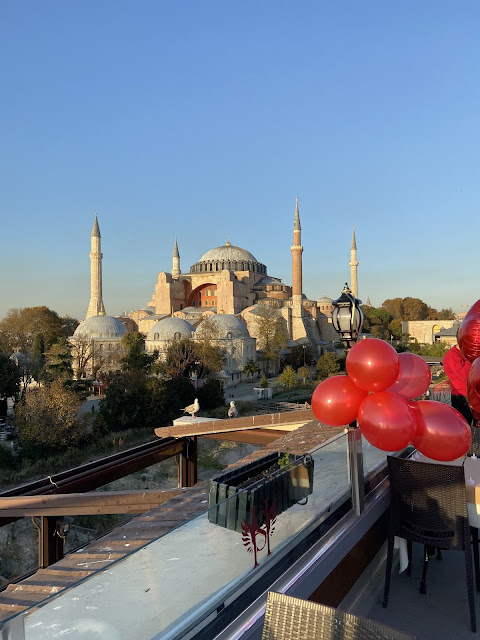Istanbul, Turkey - Day 2: Constantinople from High Up at Galata Kulesi
I had a number of things jotted down on my To-Do List when I woke up that morning on November 27, 2020. Turkish sweets I would like to try, landmarks to visit, some exploring to do in general. I'd better get started then.
It was my first time somewhere whose language or customs I had virtually no substantial knowledge of - wasn't exactly a Spanish-speaking country, France or, well, the U.K. - and ordering some simit from one of the many bakeries trailing the way up to Taksim Square, which I had strolled around the night before, proved harder than I had imagined. I attributed it to either my failed attempt at practising my non-existent Turkish (cheers, Google) or, again, an accent-related barrier, as Istanbul came across as very English-friendly.
I did get my simit in the end and I did feel like some stuffing was missing, but fair enough. To those of you wondering, simit is a circular-shaped bread, not exactly savoury, but not too sweet either, that is very popular amongst Turks (they would usually buy it from street sellers on their way to work).
Cost me around 0.80 Turkish liras (a nearly negligible seven pence) and it is surprisingly fulfilling.
Okeydoke, onwards to Taksim then the Galata District.
 |
| Galata Kulesi, one of Istanbul's most iconic landmarks |
I went to Turkey during the COVID-19 pandemic so there was a curfew in place, meaning people weren't allowed out from 9pm to 10am - or most people - as tourists like me were exempt. *Virtual shrug* as I don't make the rules.
The streets in Taksim looked a lot different in the daylight, with the Christmas lights switched off and adding to the general eerie atmosphere of the early hours.
I made my way up the Taksim High Street, well aware were it not for the global pandemic, all those shops would be open and at the expense of the occasional tourist like me.
Luckily enough, I never missed Zara.
 |
| Pictured: simit, a very popular Turkish street snack |
My first stop of the day would be at Galata Tower, one of the reasons I chose to stay in Beyoğlu in the first place, due to its proximity to a number of points of interest. It was a short 20-minute walk from Taksim to the Galata district, so I mustered all my strength following a rather wearisome previous day, rubbed the sleep off my eyes and started walking.
Galata Kulesi
After a very uneventful walk, though highly entertaining as I felt compelled to stop every 5 minutes either to capture a very charming bookshop, the odd wandering cat, or the very intriguing, hauntingly beautiful adhans from lesser mosques along the way, I spotted the iconic conical roof that is often prevalent in the Istanbul skyline.
The Galata Tower, or Galata Kulesi, is one of the oldest monuments of its kind in the world. It was originally built in 528 AD, when Constantinople was known as Byzantium, though it only acquired its present shape in 1348 by the hands of the Genoese, natives to the ancient Republic of Genoa (present northeast of modern-day Italy).
It served as an observation point for the Genoese, perched on a hilltop overlooking the Golden Horn and Constantinople in the distance (you will find an abundance of dramatic and epic-sounding names reading these articles).
Just in case you're wondering, the Golden Horn is an estuary acting as a natural defensive mechanism. It played a key role in defending the Byzantine capital from assailants. Once deemed the "impenetrable city", Constantinople was protected on all sides by four walls, known as the Constantine Walls, running across the Western frontier and the shoreline of the Horn, and kept by a succession of garrisons and heavily-armed Roman guards. Still, the cherry on top has to be what they called The Halic Chain.
Sounds grandiose, doesn't it? Well, that's because it was.
 |
| Broken section of the Halic Chain. Source: The Istanbul Insider |
The Chain - an actual chain - was a security measure consisting of raising a huge iron chain from the depths of the Golden Horn, from Constantinople to the Galata Kulesi across both sides of the water, to prevent unwelcome ships from entering the city (some sections of the chain are displayed on the Galata Museum).
Many tried to break it or circumvent it, many failed and sunk.
Worth mentioning that, back then, Constantinople was restricted to the Historical Peninsula, or the Southern shore of the Horn, as observed on the map, meaning Galata lied outside the city's boundary on the Genoese colony across the water:
 |
| Map of ancient Constantinople, facing the Galata Kulesi across the Golden Horn. Source: Ars Bellica |
 |
| The Galata Tower within the city boundaries of modern-day Istanbul. Source: IstanbulClues |
Admission fee for the tower is only 45 Turkish liras (about £4.32) and trust me, you won't want to miss it.
Not only of huge historical importance to Constantinople - some truly impressive ancient artefacts are now displayed on the newly-installed galleries inside - it offers 360° views of all of Istanbul.
 |
| Restored conical roof of Galata Kulesi seen from inside the museum |
 |
| View from the top of Galata Kulesi, overlooking the Goldern Horn and the Historical Constantinople Peninsula |
 |
| Views of Süleymaniye Mosque from Galata Tower |
Also, when visiting Galata Kulesi, make sure you don't skip the interactive room where you can emulate Hezarfen Ahmet Çelebi's flight across the Bosphorus.
Çelebi was a Istanbul native, born in the Ottoman Empire in 1609, who crafted a pair of artificial wings and took off from the top of Galata Tower, hovering over the Galata district and across the Bosphorus, a strait that acts as a natural division between the European and Asian continents, landing in the modern-day district of Kadıköy on the Asian side.
This claim is apparently very disputed, but it acts as an enthralling tale nonetheless.
 |
| Illustration depicting Çelebi's flight from Galata Kulesi, on the European side, to Kadıköy, in Asia. Source: MotleyTurkey |
Strolling around the Galata District
After climbing up the Galata Tower, don't miss out on everything else the eponymous district has to offer, consisting of Istanbul's signature snaky, narrow streets, delicious street food and bookshops.
I had only had a bite of simit at that point, so I treated myself to a bowl of fresh fruit and an assortment of various cheeses for breakfast, washing it down with gulps of ice-cold sour pomegranate juice.
Galata is one of those unique places where the old and the new clash, with centuries-old monuments still standing proud against more modern shops and buildings.
Seeing all that the district had to offer - I was in the area for around 2.5 hours, including my visit to the tower - I started making my way down the hill to catch a tram to the Historical Peninsula, Istanbul's beating heart and where the borders of Constantinople were initially drawn.
I still had a lot to fit in that day so I sped things up by using public transportation, but thankfully Turks mimicked Londoners' obsession with building bridges over the Thames and both sides of the Golden Horn are connected by many pedestrian-friendly crossings, so it should only be a perfectly feasible 30 minute walk from Galata to the peninsula.
Istanbul accomodates over 20 million inhabitants in its metropolitan zone, and were it not for the fact that a large portion of it lies in the Asian continent, it would easily claim the title of most populous city in Europe.
Bearing in mind Istanbul is such a massive, sprawling city, and many of its attractions are miles apart from each other, I didn't have time to lose in leaving Galata behind me. Otherwise, I wouldn't have minded continuing on foot as it is a very pleasing walk - and it was sunny after all.
So you are likely going to need a IstanbulKart sooner or later. It is Istanbul's Oyster and gives you access to trams, busses, the metro, the Marmaray (a train that runs underneath the Bosphorus Strait, from Europe to Asia), and any of the major ferry routes connecting the many distant districts of the city.
I topped it up with 50 Turkish liras (around a fiver in British pounds) and it proved to be enough for my five-day stay, so highly recommend getting one from one of the yellow machines available at any tram or train station, as Istanbul cab drivers tend to be quite dodgy and can make unecessarily longer journeys.
You likely won't need them anyway.
It was still only 12ish, meaning I had a full day ahead of me to peel off the layers of this striking city. It was time to head to the Grand Bazaar and Sultanahmet Square next.
Continues...












Comments
Post a Comment